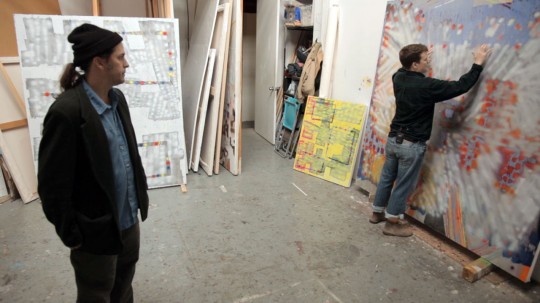
Art handler Chad Jones with artist Keltie Ferris in her studio. Bushwick, Brooklyn, 11.16.10. Production still from the series New York Close Up. © Art21, Inc. 2011.
While the film “Keltie Ferris Has a Show” is our fifth release, in many ways it’s the first. Keltie Ferris was one of our first confirmed artists. The very first shoot. Also the first edit. It’s also our first big leap of faith.
When we first met Keltie, it was a typical blind date disguised as a studio visit. We talked about movies, the way she makes her paintings, what’s important to document and what’s boring. And then Keltie said: “You see all these paintings here? They’re all leaving the studio for a show across town” When? “Next week.” Gulp.
Could we start that quickly? We didn’t really know one another. Is that important? We discovered we a shared passion for humanistic social documentaries from the 1970s, such as Harlan County U.S.A. (1976) which was filmed near where Keltie grew up in Kentucky. With quintessential labor and industrial films in mind, we decided to simply observe the paintings as they moved through the city, exchanged hands, and transformed into objects for sale and adoration.
In many ways, it was a return to the fundamentals of documentary cinema. In the edit room we eschewed the need for a formal interview to structure the experience, preferring to preserve the ambient day-in-the-life flow of one moment leading to the next. To emulate the sensitive and soft look of documentary films from 1970s, we sought out cinematographer Andrew David Watson to school us in the ways of HDSLR shooting (tricking out a still camera, like the Canon 5D, to shoot video).
Together and since, we’ve pushed the limits of that process to its breaking point: documenting artists for New York Close Up in a long-form documentary style with equipment that’s only designed to shoot in 12 minute increments (much like a reel of film) and with sound recorded separately (again, like film). It’s been an uncanny experience to use the latest technological advancements to return to a tempo and style of working that’s been out of fashion for over a quarter century with the advent of video. So in many ways, Keltie’s first shoot was a test case that this project—the technology, the stories, the scope—was in any way achievable. It gave us the confidence to move forward, and the proof that the kinds of films we hoped to make were possible. Thanks Keltie.



